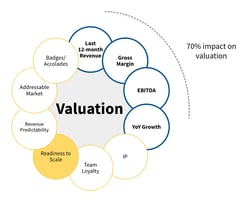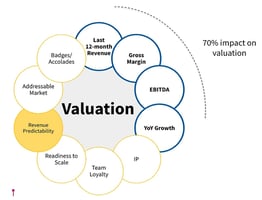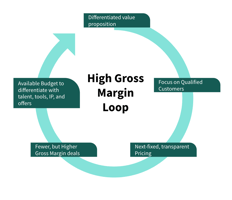Our previous blog post talked about the ingredients that represent readiness to scale for an ETS...
Demystifying ETS valuations Part 6: Addressable Market
Emerging Technology Services startups are specialist organizations. They focus on a particular market segment. They often segment the market along multiple dimensions, e.g., customer size, the problem they can solve, geography, etc.

One of the factors that drive enterprise value is the attractiveness of the target market. Four factors make a market attractive or not attractive:
Market size: It is total potential revenue available in the market. A small market can limit growth. There is a misconception that a big market is always better: a market that is too big compared to the startup claiming to service it is not viable because the startup will not be able to become a significant player in that market. A strategy some companies use is to have a broader long term market but then create a sub-segment (called sub-niche) for the time being to limit their focus to a smaller addressable market that they can conquer. Once they have conquered the sub-niche, they build to conquer the next sub-niche.
Competition: A very competitive market effectively reduces the penetration a startup can achieve. It also increases the cost of sales as one has to spend more and more resources to make themselves differentiated from their competitors. However, no competition is also not a good thing. If you are the only one in a market, it indicates a higher risk as it can imply others see something wrong with this market that you have missed. It is best to be in a market where there are a handful of players. Furthermore, it is best to be in the company of competitors who are similar to you in profile so you can be one of the visible players.
Growth: Market growth is particularly important in ETS for two reasons. First, a fast growth means that the startup grows with the rising tied which reduces cost of customer acquisition. Second, growing markets become big enough to catch the attention of larger services firms. If you decide to exit, there will be a bigger market of companies that would like to acquire you which increases enterprise value.
Barrier to entry: A market may be the right size, growing, and not yet competitive but it is less valuable if entering this market is easy. In this case, an ETS firm may just be treading the market for others. However, a market which is harder to enter is more valuable. ETS startups, by definition, have a natural barrier to entry because they are always working on emerging technologies which require talent that does not exist. Talent is thus the barrier.
As an ETS founder, you must have a clear target market and offer a differentiated service to the particular market segment. The goal shall be to establish yourself as a top player in this small segment. This allows you to reduce cost of sales because as one of the top players in the segment, your customers are more likely to seek you themselves reducing cost of lead generation ,and deals are also more likely to close because there is less competition. Furthermore, being a top specialist in the right market even if small) implies that one can charge higher pricing which improves Gross Margins and EBITDA. This puts companies more in the positive loop – where more money is available to invest and create further differentiation, which then allows them to increase margins even further. All of this increases Enterprise Value at large.
If you do not have a clear target market, or it is not meeting the criteria mentioned above, a soft pivot to have a clear addressable market is a valuable endeavor. At Vixul, we call this activity “Sharpen you Vision.” Our team can help you define or refine your target market, and optimize the decision to what you want to achieve from your ETS startup.
The other articles in our "Demystifying ETS Valuations" series are:
-
Demystifying ETS Valuations Part 4: EBITDA and the rule of 40
-
Demystifying ETS Valuations Part 5: Intelectual Property
-
Demystifying ETS Valuations Part 6: Addressable Market
-
Demystifying ETS Valuations Part 7: Revenue Predictability
-
Demystifying ETS Valuations Part 8: Team Loyalty
-
Demystifying ETS Valuations Part 9: Badges And Accolades
-
Demystifying ETS Valuations Part 10a: Readiness To Scale
-
Demystifying ETS Valuations Part 10a: Readiness To Scale




